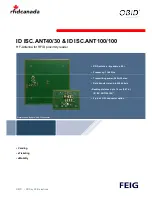
Glossary
373
condition
An message placed in an instruction line to direct the way in which the termi-
nal instructions, on the right side, are to be executed. Each condition is as-
signed to a bit in memory that determines its status. The status of the bit as-
signed to each condition determines, in turn, the execution condition for each
instruction up to a terminal instruction on the right side of the ladder diagram.
constant
An operand for which the actual numeric value is specified by the user, and
which is then stored in a particular address in the data memory.
control bit
A bit in a memory area that is set either through the program or via a Pro-
gramming Device to achieve a specific purpose, e.g., a Restart bit is turned
ON and OFF to restart a Unit.
Control System
All of the hardware and software components used to control other devices.
A Control System includes the PC System, the PC programs, and all I/O de-
vices that are used to control or obtain feedback from the controlled system.
controlled system
The devices that are being controlled by a PC System.
control signal
A signal sent from the PC to effect the operation of the controlled system.
counter
A dedicated group of digits or words in memory used to count the number of
times a specific process has occurred, or a location in memory accessed
through a TC bit and used to count the number of times the status of a bit or
an execution condition has changed from OFF to ON.
CPU
An acronym for central processing unit. In a PC System, the CPU executes
the program, processes I/O signals, communicates with external devices,
etc.
CPU Backplane
A Backplane which is used to create a CPU Rack.
CPU Rack
Part of a building-block PC, the CPU Rack contains the CPU, a power sup-
ply, and other Units. With most PCs, the CPU Rack is the only Rack that pro-
vides linkable slots.
CTS
An acronym for clear-to-send, a signal used in communications between
electronic devices to indicate that the receiver is ready to accept incoming
data.
cycle
The process used to execute a ladder-diagram program. The program is ex-
amined sequentially from start to finish and each instruction is executed in
turn based on execution conditions.
cycle time
The time required for a single cycle of the ladder-diagram program.
data area
An area in the PC’s memory that is designed to hold a specific type of data,
e.g., the LR area is designed to hold common data in a PC Link System.
Memory areas that hold programs are not considered data areas.
data area boundary
The highest address available within a data area. When designating an oper-
and that requires multiple words, it is necessary to ensure that the highest
address in the data area is not exceeded.
data sharing
An aspect of PC Link Systems and of Data Links in SYSMAC NET Link Sys-
tems in which common data areas or common data words are created be-
tween two or more PCs.
















































